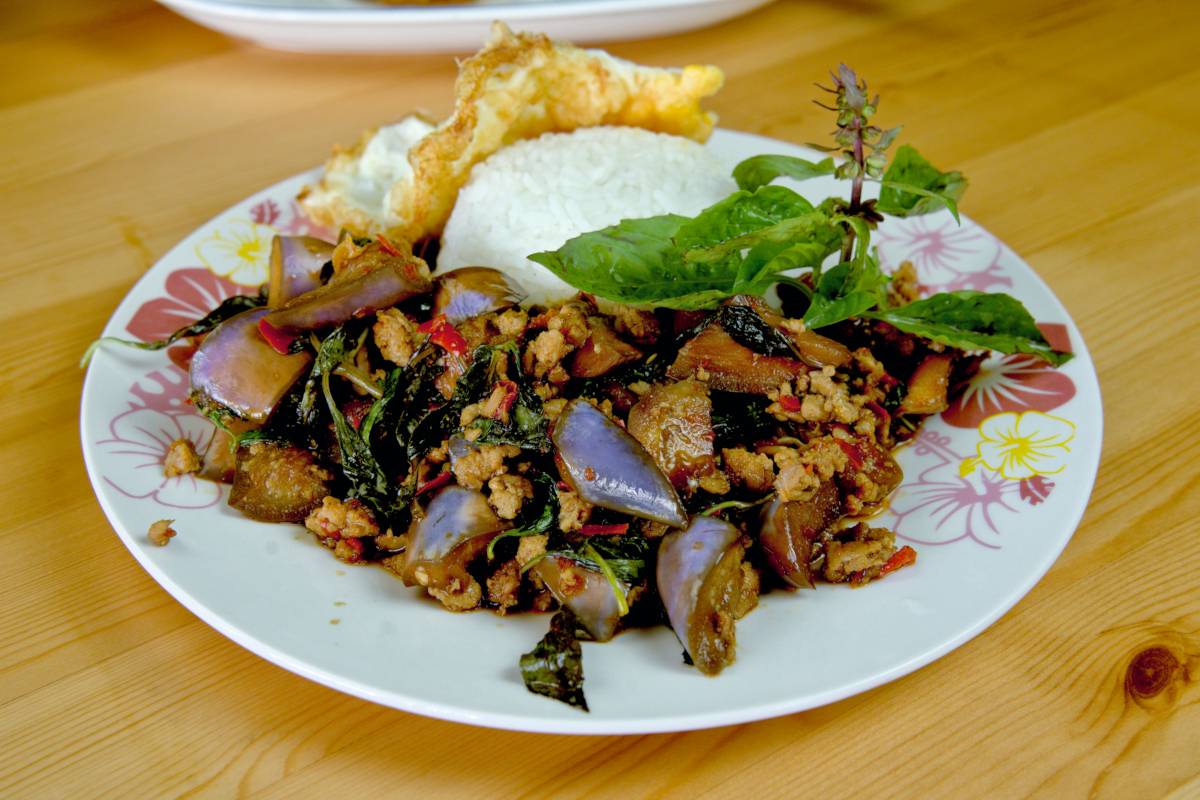Shrimp Chili Dip (นำ้พริกกุ้งสด)
“Nam Prik Goong Sot”
Nam prik goong, or “Shrimp Chili Dip,” closely resembles the Central Thai-style dish of nam prik ga-pi. However, this recipe transforms it into a standalone dish rather than just a dipping sauce. The Southern Thai version features coarsely chopped ingredients instead of finely mashed ones and involves dry roasting the shrimp paste (Ga-pi) before crumbling it into the mixing bowl.
The first time my mother-in-law prepared this dish, I was utterly amazed, and years later, my affection for it remains unchanged.
This Thai dish is simple to prepare, delicious in its straightforwardness, and authentically Thai.
Scroll down to get started – you’re sure to love this classic Shrimp Chili Dip recipe, a personal favorite of Thai cuisine.

Nam prik goong sot, Southern-Thai style shrimp chili dip
Shrimp Chili Dip (นำ้พริกกุ้งสด) or “nam prik goong sot” is a beloved Southern Thai dish enjoyed throughout Thailand.
All the ingredients are hand-chopped, a common practice in Southern Thailand. This type of chili dip does not require a mortar and pestle.
When preparing Thai dishes, always opt for the freshest and highest quality vegetables available.
Feel free to leave a comment below to share your experience with this recipe from Eating Thai Food.
Note: If you plan to pair this dish with something other than Shrimp Chili Dip, continue reading to discover the second part of this authentic Thai food recipe, “Morning Glory with Coconut Cream.”

Freshly peeled garlic and bright purple shallots
Preparation (เตรียมไว้ก่อน)
- 1 Large basin (for washing the shrimp)
- 1 Medium Saucepan (fill halfway with water)
- 1 Measuring cup (increments of 50mL are ideal)
- 1 Mixing bowl
- Knife and Cutting Board
Ingredients (ส่วนผสม)
- 500g of shrimp (กุ้งสด)
- 40g of garlic (กระเทียม) (about 12 to 15 large cloves)
- 40g of shallots (หอมแดง) (about 8 medium Thai shallots)
- 50g of Thai bird’s eye chilis (พริกขี้หนูสวน) (approximately 40 to 50 small chili peppers)
- 50g of fermented shrimp paste (กะปิ) “Ga-pi”
- 5 limes (or enough to yield 100-150mL of fresh lime juice)
- 1 tablespoon of palm sugar (or cane sugar, or brown sugar)

Peeling shrimp can be fun; try to keep that head oil intact
Instructions (วิธีทำ)
Step 1
Peel the shrimp, removing the legs, back covering shield, and tail while keeping the head oil intact. After peeling, wash the shrimp gently until the water runs clear.
In your medium saucepan, add enough water to cover the shrimp, then bring to medium-high heat. As the water boils, it will turn orange from the shrimp head oil.

The water will turn orange from the shrimp head oil
Gently stir the shrimp once or twice to ensure even cooking. Cook for about 5 to 6 minutes, just until done, to prevent a rubbery texture. Transfer the shrimp to a separate bowl to stop further cooking, and do not discard the cooking water (you should have about 300-400mL).

Roast the ga-pi paste until you smell the wonderful shrimpy fragrance
Step 2
Take 50g of fermented shrimp paste (กะปิ) “Ga-pi,” which is about three rounded tablespoons. Form it into a disc about 2 inches in diameter and half an inch thick for dry roasting.
Place the ga-pi in a dry pan (you can also roast it over fire in a traditional manner). On very low heat, dry roast the shrimp paste until fragrant, about 3 minutes on each side or until it releases a strong aroma.
Once roasted, squeeze the juice from about five limes into a measuring cup, ensuring to remove any seeds, yielding more than 100mL of lime juice. Remember to taste as you go, as the freshness of the ingredients can vary in sourness, saltiness, and sweetness.

Chopped shallots, chilis, and garlic, waiting for the ka-pi paste and lime juice
Step 3
Roughly chop the garlic, shallots, and chilies, then add them to the serving bowl. Once the shrimp have cooled enough to handle, chop them roughly and add them as well.
Crumble the roasted shrimp paste into the bowl; it should be dry on the outside but slightly damp inside, with a strong aroma. Scoop out 200mL of shrimp cooking water and pour half over the ingredients in the bowl.
Mix gently until the ga-pi begins to blend with the liquid. The Shrimp Chili Dip will be rich in all main flavor profiles – spicy, salty, sour, and mildly sweet. Taste and adjust according to your preference.

Pour on about 100mL of lime juice, watching for seeds
Pour 100mL of fresh lime juice into the bowl. If mixing by hand, consider using a plastic bag for protection (and avoid touching your eyes for a few hours).
After mixing, add another 100mL of shrimp water and continue mixing. The consistency should be clumpy, with the shrimp paste fully integrated into the liquid. Taste and adjust with more lime as desired.
Notes on Sugar:
Traditionally, sugar from Taan palm fruit is used, common in Southern Thailand, though local sugar from sugarcane or brown sugar is also acceptable. Add sugar in small increments, mixing and tasting until you reach your desired sweetness, not exceeding 1 tablespoon. We opted not to add any sugar and instead increased the lime juice at the end, allowing for customization to suit various tastes.
After the final taste test, if you prefer a more sour flavor, add fresh lime juice in increments of 1 to 2 tablespoons.
Enjoy this authentic Thai recipe, and check out our full meal recommendations for Eating Thai Style at the end of this article.

Not mandatory, but usually safer when mixing chilies by hand
Morning Glory with Fresh Coconut Cream (ผักบุ้งราดกะทิสด)
“Pak Boong Rad Ga-ti Sod“
Note: While you can use canned coconut milk for this dish, it won’t taste nearly as good as fresh coconut cream made from scratch.
To prepare this authentic Thai recipe, you will need to make your own fresh coconut cream. Read this article on how to make fresh coconut cream.
Now that we have the Shrimp Chili Dip underway, let’s move on to preparing the Morning Glory with Fresh Coconut Cream recipe.

A simple, easy to make, yet incredibly delicious dish of Thai cuisine
Preparation (เตรียมไว้ก่อน)
- 2 Large Mixing Bowls
- 1 Medium Saucepan (fill it halfway with water)
- 1 Ladle
- 1 Large Spoon
- 1 Serving Plate
Ingredients (ส่วนผสม)
- 300mL of Fresh Coconut Cream (from the first recipe)
- 500g of Thai Morning Glory (a large bunch is about 500g including stalks)
- 2g of Salt
Instructions (วิธีทำ)
Rinse the Morning Glory to remove dirt from the base of the stems (the stalks are hollow). Using a knife and a large mixing bowl, remove the large leaves and tender upper portions of the stems, placing them into the bowl. Discard the thicker, rigid lower parts of the stems.
You should be left with about 200-220 grams of Morning Glory (this is a very light vegetable).
Note: While this recipe uses Morning Glory, you can substitute any crispy green leafy vegetable.

Use the large leaves and young shoots of each stalk
How to Cook Morning Glory (วิธีทำผักบุ้งราดกะทิสด)
Fill the medium saucepan with enough water to completely cover the Morning Glory, and bring it to a rolling boil. Prepare a second mixing bowl filled with water (ice water is preferable) for the Morning Glory immediately after cooking.

You want a rolling, hard boil here for the Morning Glory
Once the water is boiling, add a large pinch of salt (about 2g) and all the tender shoots, leaves, and upper portions of the Morning Glory stalks. Ensure all the vegetables are submerged to cook evenly. The water will quickly turn green, and the vegetables will soften in just 20 to 30 seconds, remaining crisp and not soggy.

Evenly dipped into cool water immediately, after less than a minute of cooking time
To stop further cooking, transfer the vegetables to the mixing bowl filled with cold water using a ladle or large spoon, ensuring they are fully submerged. Discard the hot water from the saucepan.

Look how thick that cream is when you skim it gently off the top
Once the Morning Glory has cooled, drain the water and transfer the vegetables to a serving plate. Ensure the coconut cream has also cooled, then scoop the top layer of coconut cream over the Morning Glory until all 300mL is used.

Eventually, you will cover the whole dish in fresh coconut cream
How to Eat Thai Style:
I recommend enjoying a mix of Southern Thai-style dishes alongside this. A meal featuring Morning Glory with Fresh Coconut Cream pairs wonderfully with extremely spicy dishes like Shrimp Fried with Petai Beans (“Pad Sataw Goong Sod”), Fried Mackerel (“Pla-Tu Tod”), and a simple egg omelette (“Kai Jeow”).
More Ingredient Notes:
In Thai, this vegetable is called “Pak Boong.” The type most commonly used in home cooking in Thailand has thick, large stalks. The street food variety of Pak Boong is thinner and less sturdy, sometimes referred to as “Pak Boong Jeen” or ‘Chinese Morning Glory.’
For another recipe featuring this delightful vegetable, check out the article on ‘Red Fire Morning Glory’ or “Pak Boong Fai Daeng.”





